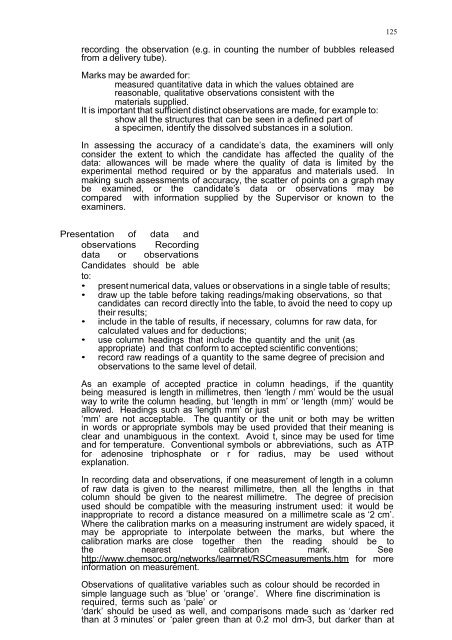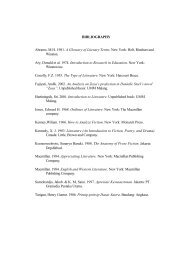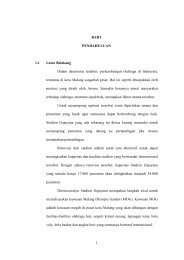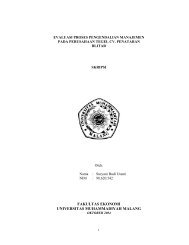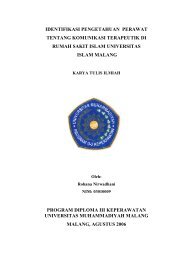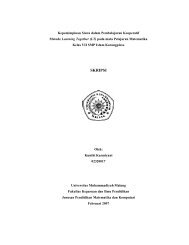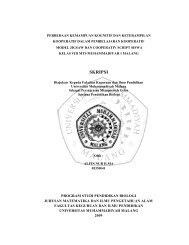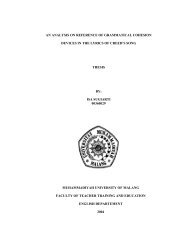File : THESIS.pdf - Universitas Muhammadiyah Malang
File : THESIS.pdf - Universitas Muhammadiyah Malang
File : THESIS.pdf - Universitas Muhammadiyah Malang
You also want an ePaper? Increase the reach of your titles
YUMPU automatically turns print PDFs into web optimized ePapers that Google loves.
ecording the observation (e.g. in counting the number of bubbles released<br />
from a delivery tube).<br />
Marks may be awarded for:<br />
measured quantitative data in which the values obtained are<br />
reasonable, qualitative observations consistent with the<br />
materials supplied.<br />
It is important that sufficient distinct observations are made, for example to:<br />
show all the structures that can be seen in a defined part of<br />
a specimen, identify the dissolved substances in a solution.<br />
In assessing the accuracy of a candidate’s data, the examiners will only<br />
consider the extent to which the candidate has affected the quality of the<br />
data: allowances will be made where the quality of data is limited by the<br />
experimental method required or by the apparatus and materials used. In<br />
making such assessments of accuracy, the scatter of points on a graph may<br />
be examined, or the candidate’s data or observations may be<br />
compared with information supplied by the Supervisor or known to the<br />
examiners.<br />
Presentation of data and<br />
observations Recording<br />
data or observations<br />
Candidates should be able<br />
to:<br />
• present numerical data, values or observations in a single table of results;<br />
• draw up the table before taking readings/making observations, so that<br />
candidates can record directly into the table, to avoid the need to copy up<br />
their results;<br />
• include in the table of results, if necessary, columns for raw data, for<br />
calculated values and for deductions;<br />
• use column headings that include the quantity and the unit (as<br />
appropriate) and that conform to accepted scientific conventions;<br />
• record raw readings of a quantity to the same degree of precision and<br />
observations to the same level of detail.<br />
As an example of accepted practice in column headings, if the quantity<br />
being measured is length in millimetres, then ‘length / mm’ would be the usual<br />
way to write the column heading, but ‘length in mm’ or ‘length (mm)’ would be<br />
allowed. Headings such as ‘length mm’ or just<br />
‘mm’ are not acceptable. The quantity or the unit or both may be written<br />
in words or appropriate symbols may be used provided that their meaning is<br />
clear and unambiguous in the context. Avoid t, since may be used for time<br />
and for temperature. Conventional symbols or abbreviations, such as ATP<br />
for adenosine triphosphate or r for radius, may be used without<br />
explanation.<br />
In recording data and observations, if one measurement of length in a column<br />
of raw data is given to the nearest millimetre, then all the lengths in that<br />
column should be given to the nearest millimetre. The degree of precision<br />
used should be compatible with the measuring instrument used: it would be<br />
inappropriate to record a distance measured on a millimetre scale as ‘2 cm’.<br />
Where the calibration marks on a measuring instrument are widely spaced, it<br />
may be appropriate to interpolate between the marks, but where the<br />
calibration marks are close together then the reading should be to<br />
the nearest calibration mark. See<br />
http://www.chemsoc.org/networks/learnnet/RSCmeasurements.htm for more<br />
information on measurement.<br />
Observations of qualitative variables such as colour should be recorded in<br />
simple language such as ‘blue’ or ‘orange’. Where fine discrimination is<br />
required, terms such as ‘pale’ or<br />
‘dark’ should be used as well, and comparisons made such as ‘darker red<br />
than at 3 minutes’ or ‘paler green than at 0.2 mol dm-3, but darker than at<br />
125


